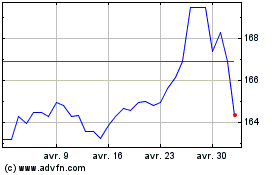RBA Minutes: Australia Economic Growth Slowed In Q2
18 Juillet 2017 - 12:45AM
RTTF2
Members of the Reserve Bank of Australia's monetary policy board
said that the country's economic recovery has slowed in recent
months, minutes from the bank's July 4 meeting revealed on
Tuesday.
That prompted the members to maintain a level of careful
monitoring for economic conditions, although the depreciating
currency rate continues to support the recovery.
On the whole, the global economy continues to recover in
satisfactory fashion, the minutes said.
At the meeting, the RBA kept its benchmark interest rate
unchanged at a record low 1.50 percent for the tenth consecutive
meeting.
The bank had reduced the rate by 25-basis points each in August
and May last year.
"The board judged that holding the accommodative stance of
monetary policy unchanged at this meeting would be consistent with
sustainable growth in the economy and achieving the inflation
target over time," the minutes said.
The Australian economy is expected to strengthen gradually, with
the transition to lower levels of mining investment following the
mining investment boom almost complete.
Business investment picked up in areas not directly affected by
the decline in mining investment. At the same time, consumption
growth remains subdued, reflecting slow growth in real wages and
high levels of household debt, RBA said.
Indicators of the labor market remain mixed, the bank noted. The
various forward-looking indicators point to continued growth in
employment over the period ahead.
"Members noted that the broad-based recovery in the global
economy had continued. There had been further signs that investment
was increasing and labor markets had tightened further in many
advanced economies. This was expected to lead to a pick-up in
growth in wages and prices over time," the minutes said.
Further, the bank said wage growth remains low, however, and
this is likely to continue for a while yet. At the same time,
inflation is forecast to increase gradually as the economy
strengthens.
The outlook continues to be supported by the low level of
interest rates.
"They assessed that current economic conditions in Australia,
and the outlook for growth and inflation, meant that developments
in the labor and housing markets continued to warrant careful
monitoring," the minutes said.
Also on Tuesday, the Australian Bureau of Statistics said that
the total number of new motor vehicle sales in Australia was up a
seasonally adjusted 1.2 percent on month in June, coming in at
102,275.
That follows the 3.1 percent jump in May.
Sales for passenger vehicles added 0.5 percent, along with
sports utility vehicles (1.4 percent) and other vehicles (1.3
percent.
The largest upward movement across all states and territories
was in the Northern Territory (2.8 percent),
On a yearly basis, sales advanced 3.6 percent, slowing from 5.3
percent in the previous month.
Euro vs Yen (FX:EURJPY)
Graphique Historique de la Devise
De Mar 2024 à Avr 2024

Euro vs Yen (FX:EURJPY)
Graphique Historique de la Devise
De Avr 2023 à Avr 2024
